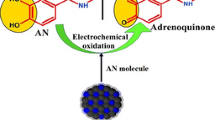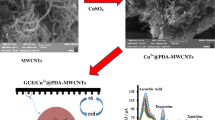Abstract
A chemically modified electrode is constructed based on a coumestan derivative and multiwall carbon nanotubes modified carbon paste electrode (CMWCNT-CPE). The surface charge transfer rate constant, k s, and the charge transfer coefficient, α, for the electron transfer between coumestan and MWCNT-CPE were estimated. CMWCNT-CPE presents a highly catalytic activity for adrenaline (AD) electrooxidation. The results show that the peak potential of AD at the CMWCNT-CPE surface shifted by about 145 mV toward negative values compared with that at the MWCNT-CPE surface. Differential pulse voltammetry exhibited three linear ranges and a detection limit of 0.2 μM for AD. For a mixture containing AD, uric acid (UA), and tryptophan (Trp), three signals corresponding to the analytes could well separate them from each other. Moreover, CMWCNT-CPE was used to determine AD in an adrenaline injection solution and UA in a human urine sample with satisfactory results. To confirm the proposed method, the AD injection solution and the urine sample were spiked with different certain amounts of AD, UA, and Trp.






Similar content being viewed by others
References
Ren W, Luo HQ, Li NB (2006) Simultaneous voltammetric measurement of ascorbic acid, epinephrine and uric acid at a glassy carbon electrode modified with caffeic acid. Biosens Bioelectron 21:1086–1092
Shahrokhian S, Ghalkhani M, Amini MK (2009) Application of carbon-paste electrode modified with iron phthalocyanine for voltammetric determination of epinephrine in the presence of ascorbic acid and uric acid. Sens Actuators B 137:669–675
Michałowski J, Hałaburda P (2001) Flow-injection chemiluminescence determination of epinephrine in pharmaceutical preparations using raw apple juice as enzyme source. Talanta 55:1165–1171
Lin Z, Wu X, Lin X, Xie Z (2007) End-column chemiluminescence detection for pressurized capillary electrochromatographic analysis of norepinephrine and epinephrine. J Chromatogr A 1170:118–121
Su Y, Wang J, Chen G (2005) Determination of epinephrine based on its enhancement for electrochemiluminescence of lucigenin. Talanta 65:531–536
Carrera V, Sabater E, Vilanova E, Sogorb MA (2007) A simple and rapid HPLC-MS method for the simultaneous determination of epinephrine, norepinephrine, dopamine and 5-hydroxytryptamine: application to the secretion of bovine chromaffin cell cultures. J Chromatogr B 847:88–94
Solich P, Polydorou CK, Koupparis MA, Efstathiou CE (2000) Automated flow-injection spectrophotometric determination of catecholamines (epinephrine and isoproterenol) in pharmaceutical formulations based on ferrous complex formation. J Pharm Biomed Anal 22:781–789
Gosetti F, Mazzucco E, Gennaro MC, Marengo E (2013) Simultaneous determination of sixteen underivatized biogenic amines in human urine by HPLC-MS/MS. Anal Bioanal Chem 405:907–916
Luczak T (2009) Comparison of electrochemical oxidation of epinephrine in the presence of interfering ascorbic and uric acids on gold electrodes modified with S-functionalized compounds and gold nanoparticles. Electrochim Acta 54:5863–5870
Wang Y, Chen Z (2009) A novel poly(taurine) modified glassy carbon electrode for the simultaneous determination of epinephrine and dopamine. Colloids Surf B 74:322–327
Hu GZ, Zhang DP, Wu WL, Yang ZS (2008) Selective determination of dopamine in the presence of high concentration of ascorbic acid using nano-Au self-assembly glassy carbon electrode. Colloids Surf B 62:199–205
Moraes FC, Golinelli DLC, Mascaro LH, Machado SAS (2010) Determination of epinephrine in urine using multi-walled carbon nanotube modified with cobalt phthalocyanine in a paraffin composite electrode. Sens Actuators B 148:492–497
Goyal RN, Bishnoi S (2011) Simultaneous determination of epinephrine and norepinephrine in human blood plasma and urine samples using nanotubes modified edge plane pyrolytic graphite electrode. Talanta 84:78–83
Wang MY, Xu XY, Yang F, Zhang SY, Yang XJ (2008) Development of an amperometric sensor for simultaneous determination of uric acid and ascorbic acid using 2-[bis(2-aminoethyl)amino]ethanol, 4,4′-bipyridine bridged dicopper(II) complex. J Appl Electrochem 38:1269–1274
Wang Z, Xia J, Zhu L, Zhang F, Guo X, Li Y, Xia Y (2012) The fabrication of poly (acridine orange)/graphene modified electrode with electrolysis micelle disruption method for selective determination of uric acid. Sens Actuators B 161:131–136
Zare HR, Shishehbore MR, Nematollahi D (2011) A highly sensitive and selective sensor on the basis of 4-hydroxy-2-(triphenylphosphonio)phenolate and multi-wall carbon nanotubes for electrocatalytic determination of folic acid in presence of ascorbic acid and uric acid. Electrochim Acta 58:654–661
Babu RS, Prabhua P, Narayanan SS (2011) Selective electrooxidation of uric acid in presence of ascorbic acid at a room temperature ionic liquid/nickel hexacyanoferarrate nanoparticles composite electrode. Colloids Surf B 88:755–763
Guan Y, Wu T, Ye J (2005) Determination of uric acid and p-aminohippuric acid in human saliva and urine using capillary electrophoresis with electrochemical detection: potential application in fast diagnosis of renal disease. J Chromatogr B 821:229–234
Munoz JA, Lopez–Mesas M, Valiente M (2010) Development and validation of a simple determination of urine metabolites (oxalate, citrate, uric acid and creatinine) by capillary zone electrophoresis. Talanta 81:392–397
Lykkesfeldt J (2000) Determination of ascorbic acid and dehydroascorbic acid in biological samples by high-performance liquid chromatography using subtraction methods: reliable reduction with tris[2-carboxyethyl]phosphine hydrochloride. Analy Biochem 282:89–93
Tang H, Hu G, Jiang S, Liu X (2009) Selective determination of uric acid in the presence of ascorbic acid at poly(p-aminobenzene sulfonic acid)-modified glassy carbon electrode. J Appl Electrochem 39:2323–2328
Jin GP, Lin XQ (2004) The electrochemical behavior and amperometric determination of tyrosine and tryptophan at a glassy carbon electrode modified with butyrylcholine. Electrochem Commun 6:454–460
Tang X, Liu Y, Hou H, You T (2010) Electrochemical determination of L-tryptophan, L-tyrosine and L-cysteine using electrospun carbon nanofibers modified electrode. Talanta 80:2182–2186
Fang B, Wei Y, Li M, Wang G, Zhang W (2007) Study on electrochemical behavior of tryptophan at a glassy carbon electrode modified with multi-walled carbon nanotubes embedded cerium hexacyanoferrate. Talanta 72:1302–1306
Huang KJ, Xu CX, Xie WZ, Wang W (2009) Electrochemical behavior and voltammetric determination of tryptophan based on 4-aminobenzoic acid polymer film modified glassy carbon electrode. Colloids Surf B 74:167–171
Agboola BO, Vilakazi SL, Ozoemena KI (2009) Electrochemistry at cobalt(II)tetrasulfophthalocyanine-multi-walled carbon nanotubes modified glassy carbon electrode: a sensing platform for efficient suppression of ascorbic acid in the presence of epinephrine. J Solid State Electrochem 13:1367–1379
Ensafi AA, Taei M, Khayamian T (2010) Simultaneous determination of ascorbic acid, epinephrine, and uric acid by differential pulse voltammetry using poly(p-xylenolsulfonephthalein) modified glassy carbon electrode. Colloids Surf B 79:480–487
Zare HR, Nasirizadeh N (2010) Simultaneous determination of ascorbic acid, adrenaline and uric acid at a hematoxylin multi-wall carbon nanotube modified glassy carbon electrode. Sens Actuators B 143:666–672
Gentil V, Lader MH, Kantamaneni BD, Curzon G (1977) Effects of adrenaline injection on human plasma tryptophan and non-esterified fatty acids. Clin Sci Mol Med 53:227–232
Zare HR, Nasirizadeh N (2006) Electrocatalytic characteristics of hydrazine and hydroxylamine oxidation at coumestan modified carbon paste electrode. Electroanalysis 18:507–512
Zare HR, Nasirizadeh N, Golabi M, Namazian M, Mazloum-Ardakani M, Nematollahi D (2006) Electrochemical evaluation of coumestan modified carbon paste electrode: study on its application as a NADH biosensor in presence of uric acid. Sens Actuators 114:610–617
Nasirizadeh N, Shekari Z, Zare HR, Shishehbore MR, Fakhari AR, Ahmar H (2013) Electrosynthesis of an imidazole derivative and its application as a bifunctional electrocatalyst for simultaneous determination of ascorbic acid, adrenaline, acetaminophen, and tryptophan at a multi-wall carbon nanotubes modified electrode surface. Biosens Bioelectronics 41:608–614
Laviron E (1979) General expression of the linear potential sweep voltammogram in the case of diffusionless electrochemical systems. J Electroanal Chem 101:19–28
Zare HR, Shekari Z, Nasirizadeh N, Jafari AA (2012) Fabrication, electrochemical characteristics and electrocatalytic activity of 4-((2-hydroxyphenylimino)methyl)benzene-1,2-diol electrodeposited on a carbon nanotube modified glassy carbon electrode as a hydrazine sensor. Catal Sci Technol 2:2492–2501
Nasirizadeh N, Zare HR, Fakhari AR, Ahmar H, Ahmadzadeh MR, Naeimi A (2011) A study of the electrochemical behavior of an oxadiazole derivative electrodeposited on multi-wall carbon nanotube-modified electrode and its application as a hydrazine sensor. J Solid State Electrochem 15:2683–2693
Zare HR, Nasirizadeh N, Ajamain H, Sahragard A (2011) Preparation, electrochemical behavior and electrocatalytic activity of chlorogenic acid multi-wall carbon nanotubes as a hydroxylamine sensor. Mater Sci Eng C 31:975–982
Zare HR, Nasirizadeh N, Chatraei F, Makarem S (2009) Electrochemical behavior of an indenedione derivative electrodeposited on a renewable sol-gel derived carbon ceramic electrode modified with multi-wall carbon nanotubes: application for electrocatalytic determination of hydrazine. Electrochim Acta 54:2828–2836
Antoniadou S, Jannakoudakis AD, Theodoridou E (1989) Electrocatalytic reactions on carbon fibre electrodes modified by hemine II. Electro–oxidation of hydrazine. Synth Met 30:295–304
Bard AJ, Falkner LR (2001) Electrochemical methods fundamentals and applications. Wiley, New York
Andrieux CP, Saveat JM (1978) Heterogeneous (chemically modified electrodes, polymer electrodes) vs. homogeneous catalysis of electrochemical reactions. J Electroanal Chem 93:163–168
Ensafi AA, Rezaei B, Mirahmadi Zare SZ, Taei M (2010) Simultaneous determination of ascorbic acid, epinephrine, and uric acid by differential pulse voltammetry using poly(3,3-bis[N,N-bis(carboxymethyl)aminomethyl]-o-cresolsulfonephthalein) modified glassy carbon electrode. Sens Actuators B 150:321–329
Shahrokhian S, Saberi RS (2011) Electrochemical preparation of over-oxidized polypyrrole/multi–walled carbon nanotube composite on glassy carbon electrode and its application in epinephrine determination. Electrochim Acta 57:132–138
Lu X, Li Y, Du J, Zhou X, Xue Z, Liu X, Wang Z (2011) A novel nanocomposites sensor for epinephrine detection in the presence of uric acids and ascorbic acids. Electrochim Acta 56:7261–7266
Salem FB (1987) Spectrophotometric and titrimetric determination of catecholamines. Talanta 34:810–812
Newman DJ, Price CA (1999) Renal function and nitrogen metabolites. In: Tietz textbook of clinical chemistry, 3rd edn. W.B. Saunders, Philadelphia
Li X, Zhang S, Sun C (2003) Fabrication of a covalently attached multilayer film electrode containing cobalt phthalocyanine and its electrocatalytic oxidation of hydrazine. J Electroanal Chem 553:139–145
Author information
Authors and Affiliations
Corresponding author
Rights and permissions
About this article
Cite this article
Nasirizadeh, N., Shekari, Z. Developing a sensor for the simultaneous determination of adrenaline, uric acid, and tryptophan. Ionics 20, 275–285 (2014). https://doi.org/10.1007/s11581-013-0956-4
Received:
Revised:
Accepted:
Published:
Issue Date:
DOI: https://doi.org/10.1007/s11581-013-0956-4




